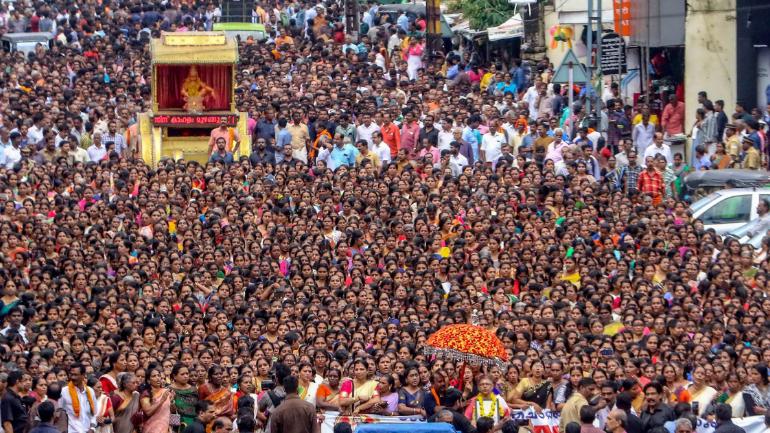 The Sabarimala Temple has received an influx of global attention since last October. In my last FAR post, I researched the origin story of the Sabarimala Temple and its dedicated deity, Ayyappan. Ayyappan’s unusual parentage and chosen attributes and patronage made him adverse to all forms of sexual activity and more importantly, not very keen in having female devotees.
The Sabarimala Temple has received an influx of global attention since last October. In my last FAR post, I researched the origin story of the Sabarimala Temple and its dedicated deity, Ayyappan. Ayyappan’s unusual parentage and chosen attributes and patronage made him adverse to all forms of sexual activity and more importantly, not very keen in having female devotees.
Ayyappan, also known as Dharmasastha, is devoted to protecting the dharma, living a yogic life, and more importantly, a celibate life. Ayyappan demands that all his followers when undertaking his pilgrimage, take a vow of celibacy for the duration. No form of sexual impurity must enter Ayyappan’s Sabarimala temple. This is where the problematic elements really start to come to head. Due to the restriction of sexual impurities, females from the age of 10-50 are denied access, as their very biological state of being female, makes them sexually impure. Their ability to menstruate makes them vessels of this apparent sexual impurity that the god Ayyappan does not want.

The earliest buildings of the Sabarimala Temple are reported to be dated to around the 1100s but it was not easily accessible until the 1200s when a dedicated path was established. From then on, the Sabarimala Temple became a highly popular South Indian pilgrimage site. As I outlined in my previous post, the Madras Government in 1893 and 1901, reported that women were being denied access to the temple. The religious praxis of the Sabarimala Temple did not necessarily stop women from partaking in the actual pilgrimage, but it did restrict them from entering into the temple to complete the pilgrimage.

In the 20th and 21st Centuries, the Sabarimala Temple would become a site of gender regulations and negotiations, highlighting the ever present and deeply integrated gender inequalities in society and religious praxis. These negotiations not only took place within small communities but also within the political arena. The Kerala High Court received a petition in 1991. The petition asked for the High Court to approve of the Sabarimala Temple’s female restrictions. Kerala’s High Court ruled in favor and stated that the restriction of women from the ages of 10-50 was acceptable as it was a customary, traditional practice. The High Court ruling also gave power to the police to enforce the customary restrictions. For the next 17 years, the Sabarimala Temple continued its denial of females from the age of 10-50.
This ruling did not stop more and more activist groups bringing awareness and initiating the call for a more gender inclusive practice for religious observations. Since the Kerala High Court ruling, the next option was to appeal to the Indian Supreme Court to rule on if the restrictions were unconstitutional. A petition was submitted to the Indian Supreme court in 2006 asking for a review on the Kerala judgement. It would take twelve years before the court would issue a ruling. On September 28, 2018, the Indian Supreme Court overturned the Kerala ruling and stated it was unconstitutional and discriminatory. Chief Justice Dipak Misra declared that the denial of women’s entrance into the Temple is not a necessary part of to Hinduism but a form of religious patriarchy. The ruling potentially also creates a precedence for stating that all forms of religious patriarchy is no longer constitutionally protected. Fellow Justice Dhananjaya Chandrachud wrote that the ban stigmatizes and stereotypes women and simultaneously places the burden of male celibacy on their shoulders.
It was a 4-1 ruling in favor of allowing women to be allowed into the Sabarimala Temple. The only dissenting vote was also the only sitting female judge, Justice Indu Malhotra. Her standpoint was that religious praxis of a specific community is not the purview of the National Courts. She also stated that she did not think rationality could be used when dealing with religious matters. I honestly don’t know how to deal with the fact that the one woman on the panel voted against allowing women access. The news reporting The Times of India outlined 5 key reasons Justice Malhotra gave a dissenting vote. The one dissenting vote does not overshadow the historical ruling mandating that the Sabarimala Temple must allow females entrance into the inner Temple.
While the ruling symbolizes a great step in gender equality, it was also met with a large outcry. The ruling caused city-wide protests and riots in the Pathanamthitta province where the Sabarimala Temple is.

The ruling also caused many Women’s Rights Activists to publicly state their intention of visiting the Sabarimala Temple. The women who flocked to the Sabarimala Temple were met by angry protestors. Women were accosted and asked if they were currently menstruating. On October 19, 2018 two women attempted to gain entrance but were threatened before they could enter the sacred staircase. Through social media, the protests and anger over allowing women entrance, gained momentum and a call for a nation-wide prayer vigil was made. The Ayyappan Jyoti was performed on December 28, 2018 across India in support of the continual ban of women. On January 2, 2019, two women under the age of 50 entered the Temple. They were escorted in by police through the staff entrance. They were also disguised as Hijras (India’s third gender: transgenders, intersex, and eunuchs). While they were successful in gaining entrance, they did not make it into the inner sanctuary due to rising violent protests outside. After the women left the Temple, priests closed to Temple to ‘ritually purify’ it.

Since the pilgrimage period has ended, the Temple is closed to the public. Time will tell how modernity plays out in the Sabarimala Temple. The current courts have ruled in favor and now it is up to the people to start to change the culture, praxis, and views. I am anxiously waiting to see how Ayyappan will have to adapt to the raising consciousness and equality of his followers and those that enter into the Sabarimala Temple.
Anjeanette LeBoeuf is a Visiting Assistant Professor at Whittier College. She is the Queer Advocate for the Western Region of the American Academy of Religion. Anjeanette also writes the for activist blog, Engaged Gaze. Her focuses are divided between South Asian religions and religion and popular culture. She has become focused on exploring the representations of women in all forms of popular culture and how religion plays into them. She is an avid supporter of both soccer and hockey. She is also a television and movie buff which probably takes way too much of her time, but she enjoys every minute of it. Anjeanette has had a love affair with books from a very young age and always finds time in her demanding academic career to crack open a new book.


The problem is not just access. The problem is the symbolism and theology associated with a “God” designed by men to exclude women from the sacred. And the saddest part of this story is that women have been brain-washed to believe that such a “God” is worthy of worship. And this of course is the power of patriarchy. It is not a Hindu problem exclusively. Women are not allowed on the holiest mountain of Greek Orthodoxy, Mount Athos, because the monks prohibit us. Here, women have not yet come together in widespread protest!
LikeLiked by 2 people
As you say Carol, this is the problem of the power of patriarchy…
LikeLike
Carol,
You bring up a great point about the underlying issues of religious systems that have been inherently segregated.
As more news comes from the Sabarimala Temple, I have kept asking questions, “What is truly at steak? Is access to the Sabarimala Temple that important? Especially in a religious tradition of millions of deities? Why is Ayyappan so important?”
And the one thing I kept coming back to is that access and representation matters.
LikeLike
Of course access matters and fighting for access led to consideration of deeper issues by Jewish and Christian feminists, and hopefully it will in this case as well by Hindu or Indian feminists.
LikeLike
Religion: Man-made, for men.
LikeLiked by 1 person
Thanks, Anjeanette, for giving us an update on Sabarimala Temple. Granting women access to this (and any other sacred space) is all well and good. However, I don’t think legal rulings “allowing” women in places from which they’ve been banned really gets to the heart of the matter. Even though “Chief Justice Dipak Misra declared that the denial of women’s entrance into the Temple is not a necessary part of…Hinduism but a form of religious patriarchy,” patriarchy has shaped (as Carol notes through its symbols and theology) Hinduism. I guess one of the questions I have is: Can Hinduism (or any other current world religion) unpatriarchilize itself? Seems the very stuff that makes up our current world religions is way androcentric. Perhaps legal rulings are a first step. I think so often, especially if we have a Western mindset, we look to the law as the be-all-and-end-all. Legal rulings come and go. How do we effect a deeper change?
LikeLiked by 1 person
I agree with Esther Nelson’s question here too where she says: “Can Hinduism (or any other current world religion) unpatriarchilize itself?
In Christianity also the deity is often referred to as “Father, Son, and Holy Ghost.” Or simply “Our father who art in heaven.” One Eastern path, however, that I know and love, is called Taoism, and what today is called “eco-spirituality.” And that’s because it follows the teachings of nature, with great joy and love for the way nature does things. There was a time when our environment was actually collapsing, polluted waters, miserable air quality, the shifts in temperature, etc. But humanity happily has been doing its best to care for our environment, much more faithfully and with more respect than we had ever been doing before. Hooray.
LikeLiked by 2 people
Esther,
Your comments are spot on and really highlight why the Sabarimala Temple means so much more then this new court ruling.
I think it highlights the rising consciousness and voice that women across the globe are having, or maybe its because of social media and the ability to instantly connect and rally that is really at the heart of the matter.
How do we effect deeper and more importantly lasting change?
LikeLike
A key question, Esther. “How do we effect a deeper change?”
With patience. Organization. Perseverance.
Good leadership. Planning. Mutual support. ???
We who are seniors or otherwise slower and can no longer “keep up” (at the last protest walk the young people were two blocks ahead of me before I realized I’m at the “sit at the beginning or end” stage) we can support in other ways. (letters to the editor, social media, etc.)
and a bit of humour helps too….a lot.
LikeLiked by 2 people
A lot has been said by all the other women commenting here, I can only strongly agree with all of them
LikeLike